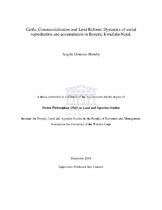| dc.description.abstract | The thesis examines the processes of social differentiation amongst households living on farms transferred through South African land reform, and the degree to which the ‘commercialisation’ of the cattle economy accounts for these processes. The evidence is drawn from six farms owned by Communal Property Associations (CPAs), which are part of the Besters Land Reform Project in the Besters District of KwaZulu-Natal. Drawing on the scholarship of critical political economists, the thesis shows that social differentiation is a dynamic process that both underlies and exacerbates conflicts over the commercial production of collectively owned cattle. This finding is derived from examining the articulation of three analytically distinct processes. These are the diversification of livelihoods in response to diminishing opportunities for regular wage employment; the social stratifications arising partly from the unequal ownership of cattle; and the differential claims on and extractions made from CPA land and cattle production. The thesis shows that some households are able to accumulate agricultural capital and expand their cattle herds by securing and synchronising a range of livelihoods, including wage employment, social grants and subsidies from CPA farm production. Others, unable to synchronise livelihoods arising from social processes that often run counter to one another, find their cattle herds depleted as they draw on them to survive. When their agricultural production declines, their capacity to generate a livelihood sufficiently robust to withstand shocks is put at risk. This places the collectively owned land, income and assets of the CPAs at the centre of a politics defined by the contradiction between meeting the needs of social reproduction on the one hand, and accumulating farm capital, on the other. This is evidenced in the dynamic nature of the hybridised farm systems in which cattle farming for multiple purposes co-exists with the production of cattle as commodities. Reflecting this materiality, the politics of the CPA draws on older relationships of kinship, underpinned by ceremonial uses of cattle that both reflect and generate broader socio-economic inequalities. The outcome of this fluid and complex ‘politics of the farm’ determines whether land reform produces a small number of ‘winners’ or a greater number of households involved in agricultural petty commodity production. Social differentiation is exacerbated on farms that disband collective production, while households are both more likely to continue farming or to re-enter agricultural petty commodity production where CPA production provides capital and labour inputs. The implications of these findings are that the problems of production on many land reform farms cannot be explained simply in terms of CPAs as troubled institutions. Rather, the dynamics of differentiation constitute CPAs and their enterprises as sites of struggle that render collectively owned production unstable under current land and agrarian policy frameworks. Policy priorities that take cognizance of this politics and support farm level adjudications of member’s rights to land, capital and cash, and support agricultural capital accumulators to exit communal property arrangements could result in limited transformations of the agrarian structure. | en_US |

